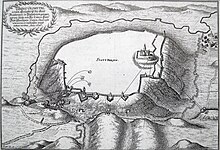Eresburg
| Eresburg | ||
|---|---|---|
|
Eresburg and Marsberg around 1670 |
||
| Creation time : | before 772 | |
| Castle type : | Hilltop castle | |
| Conservation status: | Wall remains | |
| Place: | Obermarsberg | |
| Geographical location | 51 ° 27 '1 " N , 8 ° 51' 10" E | |
| Height: | 390 m above sea level NHN | |
|
|
||
The Eresburg (today in the area of Obermarsberg , district of Marsberg in the Hochsauerlandkreis ) is the largest known (old) Saxon people's castle . The hilltop castle was 390 m above sea level. NN on a table mountain , the Eresberg, between 130 and 150 m above the Diemel , a tributary to the Weser , in the extreme south of the Saxon Gau Engern on the border with the Duchy of Franconia .
history
There are traces on the mountain that indicate that people have stayed here since prehistoric times. Ceramic remains from the Michelsberg culture were also found . Excavations near today's collegiate church also revealed evidence of moats, ramparts and posts. The radiocarbon dating indicates the origin in the pre-Roman Iron Age: After the timber has the post of trees v 420-370. Christ are to be dated.
Older research regarded the Eresburg as a border castle of the Cherusci and a fortress of Segestes , where Segestes is said to have kept his daughter Thusnelda prisoner. There is no evidence of this.
Due to its favorable border location, the mountain was repeatedly fought over and was conquered by the Frankish king Charlemagne in the course of the Saxon Wars in 772 . Charlemagne had the Irminsul located here or nearby destroyed, commissioned the Fulda abbot Sturmius in 779 with missionary work in this area and assigned him this location. As early as 784/785 Charlemagne wintered on the Eresburg and had a church built (possibly on the site of the former Saxon sanctuary). Pope Leo III is said to have been to the Eresburg in 799 on his way to Paderborn . In 915 a bloody feud between the Saxon Duke Heinrich and the East Franconian King Konrad took place at the Eresburg . Paderborn bishop Theoderich is said to have been involved in the battle . In July 938 an army of Otto I besieged the Eresburg (documented Heresburg) because the rebel Thankmar , the king's older half-brother, had holed up there . On July 28, the castle garrison opened the castle gates voluntarily for fear of the enemy’s strength, but without escaping subsequent looting. Thankmar fled to St. Peter's Church, consecrated by Pope Leo, and surrendered by placing his sword on the altar. Nevertheless, he was attacked and stabbed from behind by Maincia, a servant of his other half-brother Heinrich . King Otto regretted what had happened, but left it unpunished. Thankmar's followers were sentenced to the gallows. At the scene of the event - the collegiate church of the former Obermarsberg monastery - a crowned head is still reminiscent of a pillar.
Eresburg as the location of the Irminsul
At the Eresburg there was possibly the Irminsul , one of the highest sanctuaries of the Saxons. The formulations in the Annales regni Francorum ( Franconian Reichsannalen ) for the year 772 suggest that the Irminsul could have been either on the Eresburg or in its vicinity. The Annales Petaviani write: “He conquered the Eresburg and got to the place called Ermensul, and set these places on fire.” On the one hand, Karl conquered the Eresburg and, on the other hand, “pervenit ad locum, qui dicitur Ermensul”, d. that is, he came to the place called Irminsul. The author called the place of the Eresburg "Erisburgo", not Ermensula. The third part of the sentence says "et succendit ea loca", i. that is, he set “these places” (plural) on fire. So Karl moved on from the Eresburg.
According to other sources, Karl camped at the Bullerborn, an intermittent spring near Altenbeken , before conquering and destroying the Irminsul sanctuary in the days that followed.
The question of the location of the Irminsul is possibly misleading as there could have been several.
literature
- Gerhard Mildenberger , Fred Schwind , Jürgen Udolph : Eresburg. In: Reallexikon der Germanischen Altertumskunde (RGA). 2nd Edition. Volume 7, Walter de Gruyter, Berlin / New York 1989, ISBN 3-11-011445-3 , pp. 475-482. (introductory article)
- Daniel Bérenger: The Iron Age fortification of Obermarsberg . In: Archäologie in Ostwestfalen 6. Verlag für Regionalgeschichte, Bielefeld 2002, pp. 29–33, ( online (PDF, 552 kB) ).
- Eva Cichy: The Eresburg, Marsberg-Obermarsberg, Hochsauerlandkreis. Early castles in Westphalia 36 (Münster 2013) digitized
Individual evidence
- ^ Hermann Runte: On the history of Marsberg. Sauerland. Issue 2, 2010. Archived copy ( Memento of the original from October 27, 2013 in the Internet Archive ) Info: The archive link was inserted automatically and has not yet been checked. Please check the original and archive link according to the instructions and then remove this notice.
- ↑ Daniel Bérenger: The Iron Age fortification of Obermarsberg digitalisat (PDF; 552 kB)
- ^ Johann Suibert Seibertz: State and legal history of the Duchy of Westphalia. Vol. 1 Arnsberg, 1860 p. 15
- ↑ According to Regesta Imperii to 938 = RI II, 1N 76c in. Regesta Imperii Online (Accessed on February 11, 2015).
- ↑ WE Giefers: Eresburg, Irminsäule, Buller Born. 1878, pp. 143f.
- ↑ "u" slipped into "o" , today Bollerborn source



